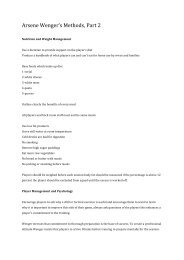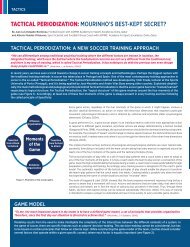Tactical Peroidization.pdf
- No tags were found...
You also want an ePaper? Increase the reach of your titles
YUMPU automatically turns print PDFs into web optimized ePapers that Google loves.
A key aspect in building the game model relates to the idea of play that the coach wants to see. It is imperative<br />
that players know exactly what they have to do in every moment of the game. A coach will want certain<br />
Tactics<br />
tactical behaviors and patterns to be revealed during the game.<br />
Principles &<br />
Sub-principles<br />
of Play<br />
Coach’s<br />
Ideas<br />
Structural<br />
Organization<br />
Players’<br />
Capabilities<br />
Game<br />
Model<br />
Moments of<br />
the Game<br />
Club’s<br />
Structure &<br />
Aims<br />
Club &<br />
Country<br />
Football<br />
Culture<br />
Figure 2. Factors that influence in designing and<br />
building up a game model.<br />
(Adapted from Oliveira, G. 2007)<br />
Thus, the model consists of principles, sub-principles, and sub-sub-principles of play that represent different<br />
moments of the game (Oliveira, 2003).<br />
The compatibility of the different principles and moments of the game is particularly important, because<br />
behaviors sometimes can be incompatible. These behaviors and patterns will express a collective dynamic<br />
behavior, revealing a certain playing identity, which could be called a functional organization. The structural<br />
organization is how the team is placed on the field; it is usually called system of play, for example 1-5-3-2 or<br />
1-4-3-3. Although the structure represents only a fixed spatial shape, it can have an important role in promoting<br />
or constraining the desired behaviors. For instance, to have good levels of ball possession and circulation,<br />
players create diagonals and “diamonds.” Some structural organizations can enhance these behaviors more<br />
than others (e.g., structures with a high number of lines, both transversal and longitudinal).<br />
Regarding players, the game model has to highlight and enhance their best features and capabilities. It is essential<br />
that the coach develop a deep knowledge of the players, especially their level of game understanding.<br />
In this regard, Frade (2003) points out that the game “has to be born first in the players’ minds.” Therefore,<br />
it is crucial for the coach to use strategies to let the players recognize the importance of certain behaviors.<br />
Consequently, the construction of the game model arises through a process that operates among the coach,<br />
players and the team itself. The coach’s constant awareness about what should happen both in collective<br />
and individual terms and what is actually happening in the game should be the driver of the training process.<br />
However, it is important to understand that the definition and creation of a clear game model should not<br />
be perceived as something that will require players to act as “robots” following a predefined plan. On the<br />
contrary, the main purpose of having a clear game model is to reduce players’ uncertainty, which should give<br />
players more time to use their creativity.<br />
The structure and expectations of a club or federation are also an important aspect in creating a game<br />
model. Coaching a team that can train only two or three times a week is different from coaching one that<br />
can practiced five days. The scope for improvement both collectively and individually is also different. The<br />
culture of the countries and clubs has to be considered when creating a game model.<br />
<strong>Tactical</strong> Periodization:<br />
methodological<br />
principles<br />
The <strong>Tactical</strong> Periodization has defined and developed unique<br />
methodological (pedagogical) principles.<br />
<strong>Tactical</strong><br />
Fatigue &<br />
Concentration<br />
Hierarchy<br />
Organization<br />
Performance<br />
Stabilization<br />
<strong>Tactical</strong><br />
Periodization<br />
Methodological<br />
Principles<br />
Horizontal<br />
Alternation<br />
Making<br />
Principles<br />
Operational<br />
Systematic<br />
Repetition<br />
Complex<br />
Progression<br />
Figure 3. Methodological principles of the <strong>Tactical</strong> Periodization.<br />
Principle of specificity<br />
“For me training means to train in specificity. That is, to create exercises that allow me to exacerbate my principles of play.”<br />
(Mourinho, in Amieiro et al, 2006)<br />
This may be the most important principle of <strong>Tactical</strong> Periodization. Specificity arises when there is a permanent relationship between<br />
all the dimensions of the game and the training exercises are specifically representative of the game model (style of play).<br />
Therefore, the concept of Specificity directs and leads the training process. In this regard, Vitor Frade (in Silva, 1998), affirms that<br />
regardless of the training exercises’ features (e.g., with more or fewer players, larger or smaller spaces), they should always be<br />
articulated in a way that enables our principles of play to be learned and used in competition. But every exercise is just “potentially<br />
specific.” The fulfillment of the Principle of Specificity will be achieved only if during training players understand the aims<br />
and objectives of the exercise, they maintain high levels of concentration, and the coach’s intervention is appropriated (Oliveira,<br />
2008). Then, specificity is related to the capacity to make operational the principles of play, and their respective sub-principles.<br />
Continued on page 31<br />
29







